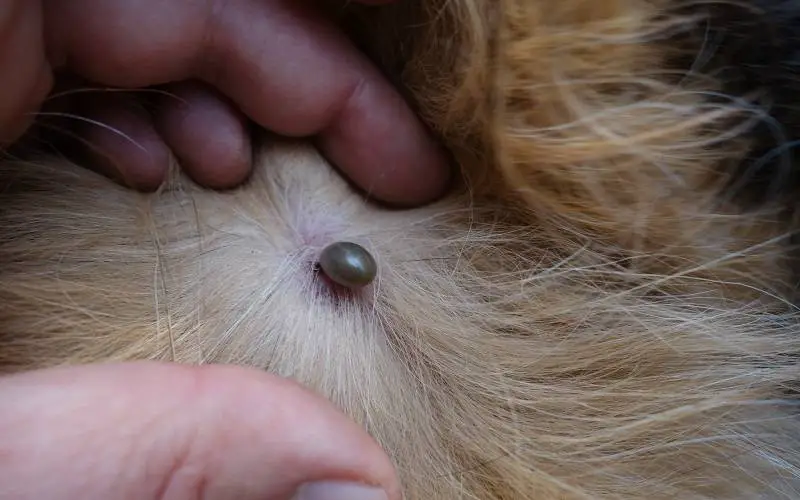patterdaleterriers.co.uk is a participant in the Amazon Services LLC Associates Program and other affiliate advertising programs designed to provide a means for us to earn fees by linking to Amazon.co.uk and affiliated sites. Affiliate links may be used on this page and in patterdaleterriers.co.uk articles, but they do not impact on the price that you pay and they do help me to get this information to you for free. Read my privacy policy for more information regarding affiliates.
If you’ve ever seen a tick on a dog, you will know that they are downright disgusting. Ticks on dogs can be extremely itchy and uncomfortable, but more worryingly, they can cause diseases in your dog such as Lyme disease. So its very important that we prevent and treats ticks on dogs properly. And of course, prevention is better than cure.
What are Ticks?
Ticks are not actually insects like fleas, they are arachnids like spiders and scorpions. Ticks have a one piece body with harpoon like barbs around its mouth to attach it to its host animal, along with crablike legs and a sticky secretion to help them to hold on. Pretty disgusting eh? There are many species of ticks – its estimated that there are around 200 species in the United States living in woodlands, long grass and even in some urban areas. They are most likely to jump onto your dog in the summer months when the problem of fleas and ticks is most prevelant.
Ticks have a four stage life cycle – egg, larvae, nymphs, and adult. Depending on the species, a tick may take less than a year or up to several years to go through its four stage life cycle. Adult females of some species lay about 100 eggs at a time. Others lay 3,000 to 6,000 eggs in each batch.
What Diseases do Ticks Carry?
Ticks can carry various infectious organisms that can transmit to your dog (and cats and even sometimes humans). There are four main diseases that you should watch out for – here they are along with their symptoms….
- Babesiosis – lethargy, loss of appetite, weakness, pale gums
- Ehrlichiosis – high fever, muscle aches
- Lyme disease – lameness, swollen joints, fever, poor appetite, fatigue, vomiting
- Tick paralysis in dogs – gradual paralysis and poor coordination
Of the four diseases, Lyme disease is the worst, as it can also infect humans. Studies indicate that dogs are 50 percent more susceptible to Lyme disease than humans. Lyme disease is transmitted through the bite of the deer tick, also known as the black-legged tick. Symptoms in humans include fatigue, chills and fever, headache, muscle and joint pain, swollen lymph nodes, and a red circular skin rash. In June 1992 the USDA licensed a dog vaccination to prevent Lyme disease in dogs. There is no vaccine for cats yet.
Ticks on Dogs – Prevention is Better than Cure
Of course as with most issues to do with Canine health, prevention is better than cure. Hundreds of pesticides and repellants are available to control ticks on dogs and cats. Products range from oral medications that are available only from your veterinarian, to collars, sprays, dips, shampoos, powders, and spot-ons. Many flea treatments will keep ticks away too. We use Frontline regularly on Blake. Frontline PLUS protects against fleas and ticks that cause Lyme disease.
If your dog is outside regularly particularly in long grass and woodland, ask the veterinarian about the Lyme disease vaccine. Watch out for the symptoms mentioned in this blog, and if you suspect a tick-borne disease get your dog to the vet immediately. With early diagnosis, antibiotics generally work. If possible, avoid known tick-infested areas. If ticks are prevalent in gardens where dogs exercise then the area should be treated with appropriate treatment to kill adult and immature ticks.
Examining Dogs for Ticks
Examine your dog frequently to make sure that there are no ticks on his or her body. Ticks prefer sheltered locations, such as inside the ears and between the toes of the host animal, but a heavily infested dog may have ticks anywhere on its body.
Removing Ticks from Dogs
When a tick is found it needs to be removed immediately. The proper way to remove a tick is to use fine-point tweezers, grasping the tick by the head as close to the skin as possible and pull gently, if the ticks mouth parts remain embedded in the animals skin, you should try to remove them as you would a splinter. Alcohol or other disinfectants should be used on the bite site, the tweezers, and your hands if you do not wear gloves. However, if you are not experienced or medically trained, it is advised that you take your dog to the vets to have any ticks professionally removed.
Once a Tick is Removed – Get Rid of it Down the Loo!
Here’s another scary part – ticks can and will survive after they are removed from the host animal. You should flush the tick down the toilet or drown them in a small container of alcohol once it has been removed. You should never squeeze a tick as it will release toxins that may contain any of the diseases mentioned earlier.
If you found this article about ticks on dogs helpful then you might also like to read about:



Very informative piece of information
Thanx
Thanks for the article! Do you think Lyme Disease can be contracted just by handling ticks or do you have to be bitten?
It’s usually the bites as far as I’m aware, but personally I wouldn’t want to risk handling either just incase!
The best way to remove a tick is turn counter clockwise and as you turn pull it fast, yes you can use tweezers but if you’re not the chicken butt type it’s better to use your fingers!!!